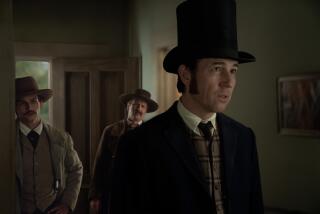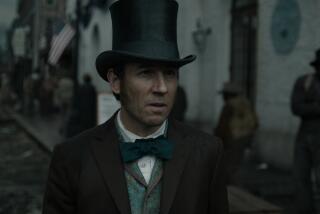Uniting a union and his Cabinet
HISTORIANS have given Abraham Lincoln rather high marks, almost always naming him our greatest president. In “Team of Rivals,” an ambitious group portrait of Lincoln and his Cabinet, Doris Kearns Goodwin sees Lincoln’s ability to unite what he called “discordant elements” as the source of his stature.
This is the most richly detailed account of the Civil War presidency to appear in many years, and it has taken Goodwin a full decade to complete. The Pulitzer Prize-winning biographer’s progress was undoubtedly sidetracked by the 2002 scandal that led to her being accused of plagiarizing source material for her biographies of the Kennedys and Eleanor and Franklin Roosevelt. Her defense then was that her methods of footnoting and paraphrasing had been sloppy. As if to show the greater care she promised to take on future projects, “Team of Rivals” is accompanied by three pages of detailed acknowledgments, 121 pages of footnotes in fine print and a 33-page index.
For the record:
12:00 a.m. Oct. 28, 2005 For The Record
Los Angeles Times Friday October 28, 2005 Home Edition Main News Part A Page 2 National Desk 0 inches; 31 words Type of Material: Correction
Lincoln book -- A review in Tuesday’s Calendar section of the book “Team of Rivals,” about Abraham Lincoln and his Cabinet, identified Treasury Secretary Salmon P. Chase as Salmon B. Chase.
In “Team of Rivals,” Goodwin has brilliantly woven scores of contemporary accounts -- letters, diaries and recollections -- into a fluid narrative that opens with the Republican Convention that nominated Lincoln in May 1860. She then travels back in time to track the converging destinies of the president and the men who joined his Cabinet and struggled alongside him until his assassination in April 1865.
More than any previous writer, Goodwin has woven in the voices of the wives, daughters and sisters of the Lincoln administration’s men, making it a vivid cultural portrait of wartime Washington. She shows, for instance, the intense social rivalry between Mary Todd Lincoln and Kate Chase, the beautiful, ambitious daughter of Treasury Secretary Salmon B. Chase.
To illuminate Lincoln’s character, Goodwin uses multiple perspectives, the viewpoints of several important Cabinet members. A key to understanding his Civil War Cabinet -- Goodwin’s “team of rivals” -- is that it was assembled by the compromise candidate of a coalition political party in existence for only half a dozen years. Four of the seven men also had been running for the presidential nomination Lincoln unexpectedly won.
All were “better known, better educated, and more experienced in public life,” Goodwin writes of Lincoln’s team. Each was seemingly far better qualified than Lincoln to occupy the country’s highest office at a time of unprecedented national peril. Even within his own party, he was seen as a kind of historical accident. But Goodwin shows that Lincoln’s nomination was not a matter of luck, as many earlier biographers have assumed. It is true that he was chosen in part for his electability, but he had worked hard to position himself as the most electable candidate.
The rejected candidates were confounded. None more so than the front-runner, New York Sen. William H. Seward, who growled that he was “justly entitled to the Republican nomination for the presidency, and ... had to stand aside and see it given to a little Illinois lawyer.” Yet Lincoln promptly named the disgruntled loser as his secretary of State, and the two became fast friends -- a prime demonstration, Goodwin asserts, of the qualities that made Abraham Lincoln a master of the art of politics.
Goodwin also traces the evolution of Lincoln’s policies on emancipation, showing that he was just a step or two ahead of the people; he never moved fast enough to threaten their commitment to Union victory. It may be the most shrewdly crafted performance in U.S. political history. Civil War America was a house doubly divided. Not only had 11 of the slave states taken themselves out of the Union, but the North was badly divided on how, and even if, the Union should be restored.
The so-called Peace Democrats opposed the Lincoln administration on nearly every issue, favoring a negotiated end to the war even if that meant Confederate independence. “War Democrats” advocated fighting to save the Union. Republicans were split into conservative and radical factions. Of course, the great dividing line was slavery. Many Northerners were committed to the Union but adamantly opposed war in order to free 4 million enslaved Southerners.
For the first 18 months of the war, Lincoln left the subject of slavery alone. Radical Republicans demanded emancipation and condemned the president as a weak leader. But Goodwin shows that his caution was grounded in hard political realities. Lincoln calculated that advocating freedom for all the slaves could shatter the coalition he had built. Only when he judged the country was ready did he issue the Emancipation Proclamation.
Goodwin argues that Lincoln’s political genius flowed from his exemplary character, his “emotional strength forged in the crucible of hardship.” Her view leads one to see Lincoln’s hatred for slavery as simple pity for the oppressed and his determination to save the Union as patriotic emotionalism.
Yet this misses an element of Lincoln’s genius: the consistency with which he clung to the free labor ideology he had embraced early on. Lincoln was a political creature for whom, according to his law partner, the rough and tumble of partisan life was “heaven.” And the United States had to be preserved not because the Union itself was sacred to Lincoln, but because America promised ordinary people “the right to rise.” Slavery had to die precisely because it so menaced that promise.
By the end of his life, Lincoln had come to believe that he was the instrument of justice chosen by a mysterious, implacable God to put an end to slavery, as he magnificently proposed in his second inaugural address. This visionary figure is not fully captured in Goodwin’s portrait.
Instead, her Lincoln sometimes seems more like a particularly skillful manager of human resources, a generous problem solver who relied on his sympathies to operate outside politics and move people’s hearts.
Nevertheless, in a most crowded field -- there are more books about Lincoln than any other figure in U.S. history -- Goodwin offers something original in her illumination of the constellation of characters that revolved around the president and in her emphasis on his personality as the key to his extraordinary political skills.
This splendid, beautifully written biography is the best book on Lincoln’s Cabinet ever written and one of the very best on Lincoln as a man and president.
John Rhodehamel is the Norris Foundation curator at the Huntington Library and organizer of its exhibition “Forever Free: Abraham Lincoln’s Journey to Emancipation.”
More to Read
Sign up for our Book Club newsletter
Get the latest news, events and more from the Los Angeles Times Book Club, and help us get L.A. reading and talking.
You may occasionally receive promotional content from the Los Angeles Times.










